mytest
Books etc. by ARUDOU Debito (click on icon):

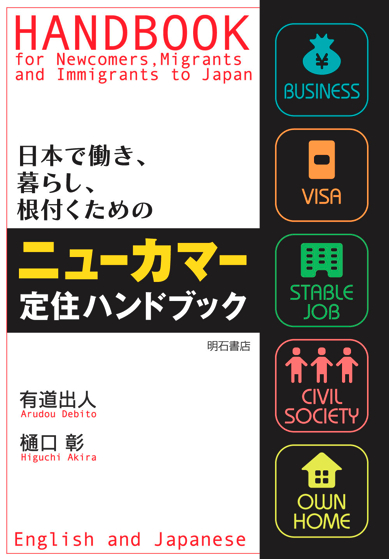


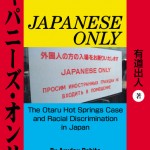
![]()

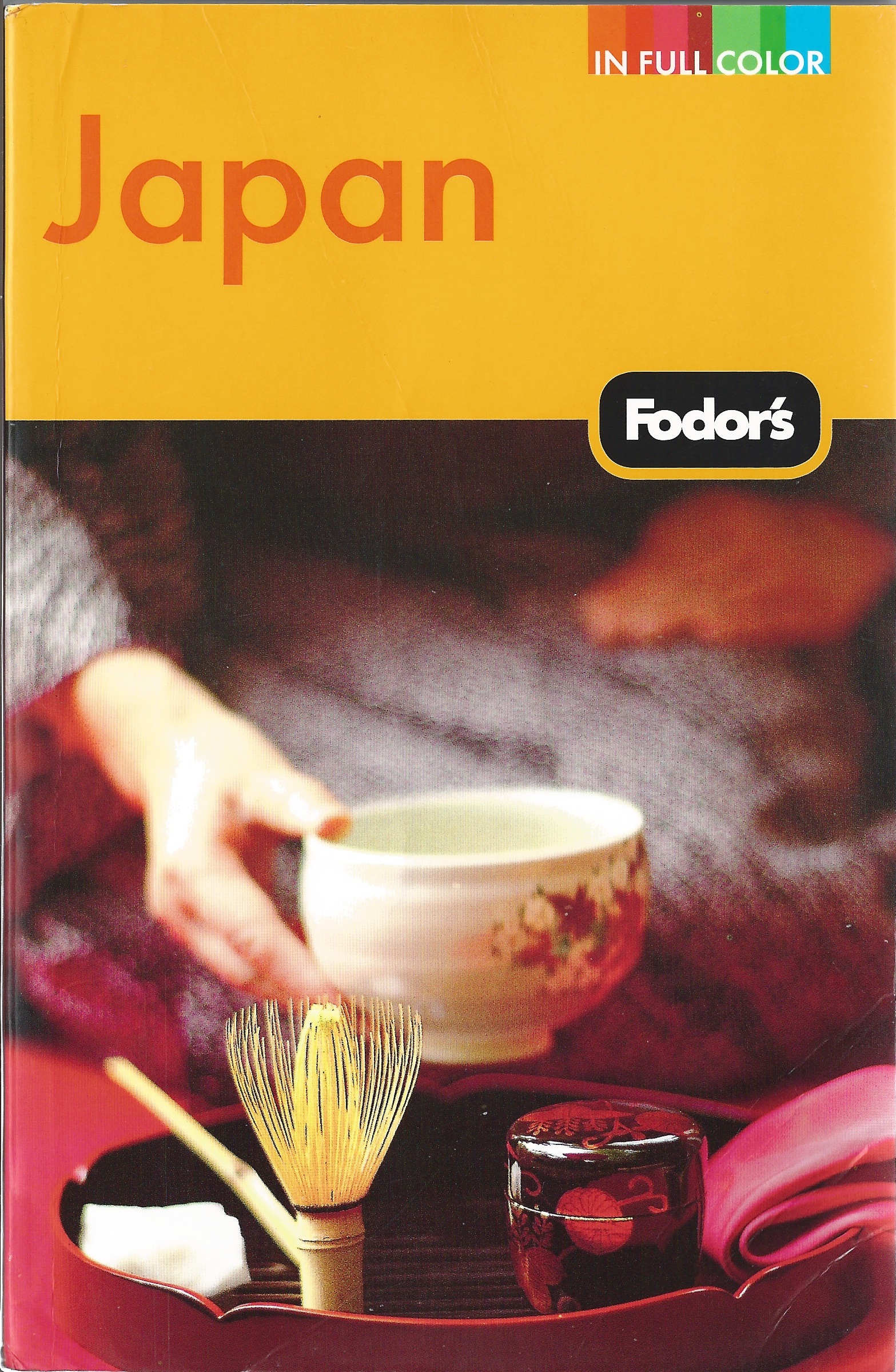
UPDATES ON TWITTER: arudoudebito
DEBITO.ORG PODCASTS on iTunes, subscribe free
Hi Blog. We have an important announcement courtesy of academic listserv H-JAPAN:
======================================
H-JAPAN
May 31, 2012
Date: Thu, 31 May 2012
From: JFMorris
Subject: Multiculturalism in Japan
Dear List members,
A committee has been set up within the Cabinet Office of Japan, composed of the vice-ministers of the Cabinet Secretariat, Ministry of Internal Affairs and Communications, Ministiry of Law, Foreign Affairs, Finance, Education etc, Health etc, Agricutlure etc, Industry etc, Land etc, Police to investigate and recommend policy on “co-existence with foreigners”. Information on the committee can be found at the following URL.
http://www.cas.go.jp/jp/seisaku/kyousei/index.html
The documentation provided here gives a very succinct summary of what the government (national level bureaucrats?) of Japan think about “foreigners” here, and how they formulate their perceptions of what the “problems” are, and very vaguely hint at where they see future solutions.
John Morris
Miyagi Gakuin Women’s University
======================================
COMMENT: Many thanks to John Morris for the link. I wish he would have elaborated on the contents of the summaries, so I will.
As concerns the goals of Debito.org (inter alia the promotion of multiracial/multicultural tolerance and and of diversity in Japanese society), here are some points of note:
=================================
SUMMARY: This is not the first time the organs of the Japanese government have talked about “coexistence with foreigners” (gaikokujin to no kyousei shakai jitsugen), but more likely than not these happen at the local level (cf. the Hamamatsu Sengen, which happened repeatedly from over a decade ago yet was studiously ignored at the national level). Now that discussion on this is taking place at the national, Cabinet level, this is a positive development. However, these meetings (two so far, the first one was less than an hour) at the outset show the hallmarks of so much Japanese policymaking: a biased agenda (with all the normalized invective of “wagakuni” (our country) semantically offsetting those foreigners (who have to “co-exist” with Japanese, not merge into one polity)) regarding the policy treatment of people without any input from the people being treated. Inevitable blind spots, such as an overemphasis on Nikkei and children’s education, are already latent in the materials below. In any case, this is a very interesting and rare view into the dialogs and mindsets behind the creation of public policy re Non-Japanese (NJ) in Japan. More detailed summaries and analysis follow below.
=================================
Here is the cover of the anchor site for this policy debate (click to enlarge):
The goal written therein is interesting: “This deliberative meeting on ‘a society coexisting with foreigners’ has been set up so that related government ministries can deliberate comprehensively in close cooperation with one another, regarding the various problems related to environmental preparations (kankyou seibi) for realizing a society where we can coexist with foreigners who have livelihoods in Japan, in order to promote the undertaking of related policies at all levels of government.” (my translation)
Okay, we’re coordinating something regarding “policy issues” (which is good, since in Japan’s tate-wari bureaucracy the ministries don’t coordinate much with each other). So who’s attending? According to the attached konkyo kouseiin for the May 24, 2012 meeting (click to enlarge):
It’s all governmental vice ministers (fuku daijin) from The Cabinet, Internal Affairs & Communications (Soumusho), Justice, Foreign Affairs, Finance, Education, Health & Welfare, Agriculture, Forests & Fisheries (how are they related?), METI, Posts and Communications, and the National Police Agency (there as a jichou). The chair is former Education Minister Nakagawa Masaharu (under the interestingly-named title of “State Minister in Charge of the Foreign Laborer Problem” (gaikokujin roudousha mondai o tantou suru kokumu daijin), meaning semantically we’ve already problematized a latent “problem” of foreigners into foreign laborers). (More on Nakagawa in Japanese at the renewed Noda Cabinet Profiles here)
Note that there is not a single Non-Japanese (NJ) involved anywhere at the agenda-setting stage. (Not even the token Gregory Clark, who never misses an opportunity to claim how open-minded the Japanese must be because officials insert him on blue-ribbon shingikai deliberation councils and committees. Maybe that’s for the better this time, since we really don’t need bigoted geriatric liars with an incredible sense of entitlement telling the GOJ what to do about NJ residents who have completely different socioeconomic statuses to his.) Anyway, it seems the government obviously knows best what to do with the “foreign laborer problem” from the outset. Who needs foreign residents’ involvement when it’s a Japan issue?
Note how there is some vital lack of definition. What does “coexistence” mean exactly — tolerance, acceptance, gated communities, patchwork cultural neighborhoods, or complete subsumption of “foreign cultures” in favor of “Japanese culture” (douka)? Nor is the “kankyou seibi” made all that clear. For example, does this this include a law (with actual penalties for offenders) against racial discrimination? People won’t leave home without it.
You can see the materials submitted to participants in the first meeting, including several reference materials from each ministry from the following links (this was clearly a meeting planned well in advance; good):
|
【配付資料】
|
||
| 資料1-1 | 「外国人との共生社会」実現検討会議の開催について | |
| 資料1-2 | 「外国人との共生社会」実現検討会議の開催について(開催要綱) | |
| 資料1-3 | 当面の検討会議スケジュール(案) | |
| 資料1-4 | 有識者ヒアリング候補者(案) | |
| 資料2 | 外国人との共生社会の実現に向けた主な論点、検討課題(例) | |
| 資料3 | 法務省提出資料 | |
| 資料4 | 厚生労働省提出資料 | |
| 資料5 | 文部科学省提出資料 | |
| 資料6 | 警察庁提出資料 | |
| 資料7 | 内閣府提出資料 | |
Material 1-1 is interesting in that the main goals are listed as:
- What form a society coexisting with foreigners will take
- What “environmental preparations” (kankyou seibi) will be undertaken to realize this society
- How to enliven (kasseika) the national debate (kokumin teki giron) which will also include the acceptance (uke ire) of foreigners
- What other topics and issues of special attention (ryuu i ten) will be involved in realizing this coexistence with foreigners
Those goals are elaborated in greater detail within Material 1-1 (more below). Prima facie, these are all positive directions, especially the national debate bit to get the public on board to convince them that NJ are also a part of society. However, unclear (as always) is the word “uke ire“, which can run the gamut of meanings from “acceptance and embracement” to “just letting them cross the border into Japan” (as in the yahoo dictionary definition example: “この国は移民の受け入れに年間2,000人の枠を設けている The quota of immigrants to be received [accepted] into this country is set at 2,000 per year.”) Given Japan’s record on immigration policy (and the fact that even the word “imin” (immigrant/immigration) doesn’t seem to be appearing anywhere, this word does not conjure as positive an example of acceptance *as Japanese residents and Japanese citizens* as one would like.
Material 1-1 also mentions in that greater detail the two steps that this plan will take: 1) GOJ deliberations on the kankyou seibi, 2) public debate on how to “accept foreigners”. However, this will take place ONLY AFTER the kankyou seibi are firmly established. The policy aim also stresses that it policy is not to be expanded to accept more foreigners (uke ire kakudai), but rather it is important first “to improve the many problems of foreigners who are actually living in our country”, listed as issues of lifestyles, education, labor conditions etc.. Kankyou seibi must be done first, however. Then, however, if I’m not somehow misunderstanding this, it stresses in the next paragraph how our country must increase its attractiveness and appeal as a place that will “draw foreigners in to revitalize our society” (wagakuni shakai ni katsuryoku o motarasu gaikokujin o hikitsukeru). Somehow I have the feeling I’ve heard this before. And again, a “smooth public debate” is fine. But how about seibi-ing that legal environment to outlaw discrimination? Not clear.
It’s not any clearer when you read the finer print. Material 2 above lists these as the problems to be addressed already (paraphrases):
- Our country needs high-quality people (koudo jinzai) to keep us vibrant in this era of globalization and aging/falling Japanese population, so for that dynamism we need foreigners.
- There have been “social costs” (shakaiteki kosuto) to bringing foreigners into our country before, particularly in regards to lifestyles, education, and labor, so this should not be broadened due to [and I’m seriously translating this bit:] “being opened up as an international society will probably lead to our country’s reputation being downgraded” (kokusai shakai ni okeru hirakareta kuni to shite no hyouka o teika saseru koto ni mo tsunagaru). [Moodys, are you listening?]
- We want to attract “better foreigners” (again, koudo jinzai), given what happened with the Nikkei South Americans and NJ residents living here so far, with more systematic policies to bring them in and maintain our country’s reputation.
- We need these plans to be medium- and long-term, given the demographics.
- We need to keep our people (kokumin) in the debate loop and build consensus for the future about bringing in foreign labor.
Wow, what paroxysms of grief those lackluster NJ entrants up to now have put Japanese society through! That said, these are the things (page 3) this panel is thinking about regarding how to treat NJ (in other words, its not just what we can take from NJ, but also what we need to give them):
- Policies that will make them functional in Japanese (e.g., promotion of J language learning in local areas, with appraisals, encouragement of teachers, and possible requirement (gimu zukeru koto) [for visa renewals?])
- Educating their children (e.g., stopping school absenteeism, putting in qualified J language teachers in public schools, assisting NJ children into higher-quality education, promoting education in NJ schools [!!!], promoting J language education for their parents, offering NJ children other educational opportunities, etc.)
- How they will be hired and will work (e.g., not merely treating them as cheap labor but improving their working conditions and social insurance, with job training in sectors such as nursing, agriculture etc., through bringing in higher-skilled workers, and even think about a “foreign employment law” (gaikokujin koyouhou) [!!!] This would not be limited to the Nikkei South American workers [was it implicitly before?])
- How they will have medical treatment and social security (e.g., get them on Social Insurance, get their kids covered, and think about to set up an effective translation system)
- Stable places for them to live (e.g., offer basic information about how and where to live, and take measures to alleviate the fears of private-sector landlords afraid of NJ)
- How to deal with “public safety” problems (e.g., how to police NJ in this age of globalized crime)
- How to make information available in several languages (e.g., multilingual internet sites, more information sent overseas [??], one-stop information and assistance centers, multilingual disaster information, multilingual traffic information and driver license tests)
- Mutual respect for each others’ culture and promoting understandings (e.g., multicultural education, and thinking about introducing an integrated program for Japanese studies as soon as people enter Japan)
- How to work in coordination with local governments and burden-share (e.g., have local governments understand the needs of their local NJ and offer them concrete and customized service) Etc.
There are further clarifications for each subject from page 4 onwards (listed in parentheses afterwards). This is some very heady and prescient stuff (I can see why bureaucrats don’t want sweaty-headed public debate meddling until they get the “environment” set up first), and something which if carried out will be a great improvement over the past. However, unclear again is how some issues (such as apartment refusals) will be enforced through the existing legal/administrative framework, or how the present system will be changed to make jobs more secure and equal in treatment (such as in Japanese academia (which I happen to know a bit about), which advertises that it wants foreign PhDs but then only offers them limited-term contracts, not tenure or an equal collegial footing). Nice to have this wish list. Better to say, however, that we need legal structure (hou seibi) to back it up, even at this drawing-board stage.
The MOJ’s brief (Material 3 above) starts out with bare stats of who and how many NJ are here and what they are up to. But then on page 7 they get into how NJ should be administered (kanri — natch, that’s their job). But it uses the hackneyed kokusaika (internationalization) of Japan just in terms of numbers without (as usual) indicating an understanding about what true internationalization really means (as in making NJ into Japanese). Instead, the MOJ focuses (as usual) on how little control they have over NJ once they pass through Japan’s borders, and advocates the quick implementation of policy carrots and sticks — carrots portrayed as keeping tabs on NJ’s social welfare and children’s education (as if that’s within their mandate), and sticks meaning visa overstayers get rooted out ever more efficiently. We’ve seen this in action in the upcoming end of the Gaijin Cards (in favor of remotely-trackable Zairyuu Cards (mentioned on page 8 ) that link visa approval to enrollment in Japan’s insolvent pension schemes), and it’s pretty plain to see who’s engineered that future fiasco. If you’re ready for a giggle, check out the smiling “example NJ” on page 9 being subjected to this proposal, complete with white skin and blue eyes (even though most of the NJ these labor policies will attract are probably not White people — because they never have been). In sum, the MOJ offers nothing new except more policing.
The Health & Welfare Ministry’s brief (Material 4 above) offers the background information on what NJ are up to again, but has on page 2 a special focus (over half the page) on how to care for Nikkei NJ (displaying once again that GOJ focus on offering more assistance “to the family” linked by Japanese blood). The measures proposed are decent (mentioned in the Material 2 outline above). For the the garden-variety NJ, however, it’s not clear what’s to be done as discrimination by nationality in working conditions and in introductions to jobs is already “outlawed” (kinshi) (as if that’s made much difference up to now). But the Ministry points out (page 3) how there’s no clause in the laws guaranteeing equal treatment regardless of nationality in the social insurance system, and wants improvements made regarding how foreigners are employed. The solution to this Ministry is the upcoming revisions in the registry rules to make everyone accountable under the pension and social welfare systems. Not much new here — no mention of how to stop J employers screwing their NJ workers out of social insurance by not paying their half of the required contributions, for example. A newer idea, however, is on page 4, where they outline the policy for attracting higher-quality NJ (again, koudo jinzai), i.e., a “points system” (itself highly problematic) for which came into effect May 7 of this year; the Ministry wants 300,000 “shitsu no takai” foreign students etc. to be handled under “job matching” systems at Hello Work unemployment agencies nationwide. It also wants GOJ assistance with post-university job searches and internships, and reformed personnel management with clearer hiring practices for international workers. Okay, decent stuff, but let’s wait and see if any of this comes to fruition.
The Ministry of Education’s brief (Material 5 above) is brief indeed, with a rehash of what they say they concluded in May 2010: Deliberation of how to institute Japanese language education environments in Grade School and Junior High, and allowing NJ schools in Japan to become educational foundations [!!!]. More details are on page 2, where details of note include an increase of Japanese-language teachers by 350 souls (to a total of 1385 people nationwide) since 2009, making and distributing educational guidebooks, yada yada. Also notable is the lumped treatment of J “returnee children” (rendered as kikoku/gaikokujin jidousei) as foreigners. No mention of reforming the Basic Education Law (kyouiku kihon hou) to also guarantee education to non-citizens (given the restrictive kokumin clauses already within it, which still enables Japanese schools to refuse NJ children). No anti-bullying discussions, either, or possible sensitivity training workshops for teachers if not students. MoE’s assumptions within its lackluster proposals seem to be that if you make some motions to teach foreigners (and somehow by extension returnee Japanese) the Japanese language, they’ve done their job and all’s resolved nationwide.
The National Police Agency’s brief (Material 6 above) is even briefer, with one page of crime stats (which has dramatically fallen across the board yet they managed to squeeze in a crime rise somehow — i.e., NJ as collaborators with Japanese in Japanese crimes) with fingers pointed at Chinese, Vietnamese, Peruvians, and Brazilians as inter alia thieves and marriage visa defrauders.
They offer no proposals whatsoever. Why are they even in on this discussion? (The MoJ is already offering enough policing.) Do we get the police involved on every social policy reform council, or is it just because we’re dealing with inherently untrustworthy criminal NJ?
The Cabinet’s brief (Material 7 above) offers a full overview of “our own” — with seven pages concentrating solely on Nikkei NJ. Aside from this more-than-just-a-little offensive blood-fixation prioritizing of foreigners in Japan, we have observations about how these days Nikkei cannot get jobs or get Japanese language skills, their kids cannot get an education, and how they’ve taken emergency policies since January 2009 (as opposed to the GOJ’s emergency airlift of Nikkei — only — back to South America from April 2009?). The rest of the proposals are basically as above, in what seems to be a summary of everyone’s positions.
================================
Future discussions (a total of five meetings, through July, according to Material 1-3 above) will involve a hearing with experts in the field on “the shape of the NJ coexistence society” (Meeting 2, June 1, details below); another meeting with those experts “about taking on the issues ‘in the field’ (genba de) where NJ have their livelihoods” (Meeting 3, June 15, preliminary details below); yet another meeting with those experts about accepting those NJ (regarding “views” (shiten) and “issues warranting special attention” (ryuu i ten) in accordance with realizing that co-existence society) (Meeting 4). And finally, the last scheduled meeting for now will bring the previous meetings’ discussions together to consider a 25-year tentative plan for realizing those concrete policies for kankyou seibi.
It’s a better-formed plan and timetable for discussing these issues than I’ve ever seen before (and it’s also been opened to public scrutiny). All good, but here’s your scrutiny:
I still have no idea what kankyou seibi is (neither do they, I think; that’s why they’re getting together to discuss it). But the inputs are as usual limited to people (presumably no women, no young people, and no working-class people) who will never be directly affected by this policy because they have never been foreigners in Japan. I’m probably reading too much into the following, but semantically, NJ are seen as almost a different breed of animal that needs to be studied in their natural habitat. Still no sign of any of those NJ animals being let in on any GOJ meetings to speak for themselves.
===================================
Meeting Two was held very promptly afterwards, on June 1, 2012, and for what looks to have been a longer time (two hours on paper). Here’s the cover page (click to enlarge):
Now involved are three “persons of awareness” (yuushikisha), who are a Mr. Ikegami Shigehiro (a full professor from Shizuoka’s University of Art and Culture, who writes a lot about Indonesian culture and migrant Indonesians; even uses the word “emigrants”), a Mr. Iguchi Yasushi (a former bureaucrat at the Ministry of Labor turned full professor at Kansai Gakuin University, whose specialty is the unemployed and labor migration; here’s his CV in English), and a Mr Satou Gun’ei (Vice Dean at Tokyo Gakugei University’s Center for Research in International Awareness, whose specialty is on transnationals and Japanese language education, particularly Japanese children overseas).
Again, these people are no doubt well-intentioned and well-researched about situations facing NJ in Japan. But they are not NJ, with “NJ awareness”; there is no substitute for that.
You can see their submitted materials here (along with other materials from that meeting) from these links:
|
【配付資料】
|
||
| 資料1 | 池上氏提出資料 | |
| 資料2 | 井口氏提出資料 | |
| 資料3 | 佐藤氏提出資料 | |
| 参考資料1 | 「外国人との共生社会」実現検討会議の開催について(要綱) | |
| 参考資料2 | 当面の検討会議スケジュール | |
| 参考資料3 | 有識者ヒアリング参集者 | |
| 参考資料4 | 外国人との共生社会の実現に向けた主な論点、検討課題(例) | |
Another brief summary of the materials above:
Mr Ikegami (Material 1) offers an overview that goes beyond Nikkei to include Chinese and Filipinas/nos too. Aside from overviews of the economic forces at work on NJ labor, he saliently proposes (of note): 1) officially defining “multicultural coexistence” (tabunka kyousei), 2) coordinated entry and social integration procedures, 3) regional coordination that includes NJ, etc. He also endorses an awareness of “transnational livelihoods”, not dividing the issue into “Japanese and foreigners”, etc. His heart’s in the right place, but proposals are still at the slogan stage. I assume he elaborated on his points orally.
Mr Iguchi (Material 2) has a five-pager that still resorts to the divisive “wagakuni” (our country) invective, but still endeavors to portray NJ as deserving something more than just a ticket home. He stresses the issue of “social integration” (shakai tougou). He writes a bit of fluff here and there that the bureaucrats are probably not interested in (such as the treatment of Burmese refugees), but does overturn a few unconsidered stones: how the mixed bag of overseas policies towards foreign “cultural identities” have resulted in potential backlashes if they are not respected; how “multicultural coexistence” is not an imported concept in Japan’s case, but one generated from Japan’s grassroots — i.e., from Japan’s local governments, such as when Kawasaki City passed policies in the 1990s benefiting “foreign-national residents”; how important language is for not only communication, but also for securing permanent residency and citizenship [!!]; how NJ rights must be respected and enforced through Hello Work and local governments [!!], etc. He advocates immediately 1) the GOJ use the July NJ registration reforms as an opportunity to get Hello Work and local governments helping NJ enlisted in employment insurance and social insurance, as well as to promote secure jobs for them, and 2) get employers to properly insure their NJ employees and ensure flexibility towards covering their families. He advocates that within the next five years NJ get up to speed in Japanese through standardized education, evaluation, and systematic accreditation of J language teachers. Beyond that, mid-term suggestions include 1) proper technical accreditation for young NJ trained technicians aimed at properly matched markets, 2) periodic lists of vocations in desperate need of workers and training programs for NJ to fill them, 3) exchanges through educational accords with other countries at the university level to bring in foreign researchers and students (as well as beef up language accreditation for imported NJ workers, with targeted language education for them; example cited being the plight thus far of foreign nurses and health care workers). His final, underlined conclusion was that to restore Japan’s economic vitality, it is essential to bring in NJ (specifically high-quality foreign labor, Nikkei, technical trainees, and refugees [!!] for specific industries, and to accomplish that, concrete policies are necessary to encourage proper administration of NJ as well as encourage social integration at the national, regional, and local levels. Surely true. The attitude, however, is still one of “we’re going to wipe the slate clean and start treating foreigners better from when they enter at the border”, not one of making things better for the NJ already here. Ah well, gotta start somewhere, I suppose.
Mr Satou (Material 3) offered a bullet-point summary, focusing on 1) the present state of NJ children’s education, 2) evolution of the characteristics of educational policies towards NJ children, 3) issues within those education policies, and 4) future issues with a view towards multicultural coexistence. Quite frankly, it was jolly difficult for me to understand within which was an observation and which was policy advice. Some points made that don’t overlap Ikegami’s and Iguchi’s, to wit: 1) education of NJ has not developed into talk of reform of the education system to accommodate them, but rather of how individuals will cope with their education, 2) basic principles of guarantees of rights from the perspective of multiculturalism must be made clear before proper “acceptance” (uke ire) can take place, 3) Japanese children should be schooled in tolerance of others as fellow residents (shimin — rendered later as “citizens” (as in shiminsei no kyouiku, “citizenship education”)). Good stuff and better constructs included, especially the new civics lessons, but in the end, this came off as a laundry-list outline/survey of issues and problems with relatively unclear proposals.
====================================
Meeting 3, according to Material 1-4 distributed May 24, 2012, says that the June 15 hearing will involve the mayor of Hamamatsu City, Shizuoka Prefecture (since so many NJ are clustered there working in factories), the unnamed head of Tokyo Shinjuku-ku (where “a lawless zone of foreign crime” Kabukicho is; I assume a bureaucrat?), a Mr Tamura Taro, representative of the Multicultural Center Osaka (which works a lot with Nikkei Brazilian issues), and a Ms Sakamoto Kumiko, head of NPO Aidensha (which works with Portuguese speakers etc. in Mie Prefecture explaining Japan’s rules, helping them get homes and proper insurances, and assisting in translations etc.)
Again, all no doubt well-intentioned people. A bit top-heavy on the Nikkei Brazilian front, again. I guess Chinese aren’t prioritized as highly due to a lack of blood ties, and where are the Peruvians, Filippinas/nos, and other NJ?
The remaining materials were essentially repeats of the earlier materials. Enough; my eyes are tired. Points I missed or got wrong, please feel free to correct. Thanks for reading. Arudou Debito
UPDATE JUNE 27, 2012: MEETING THREE OF JUNE 15, 2012 CRITIQUED HERE:
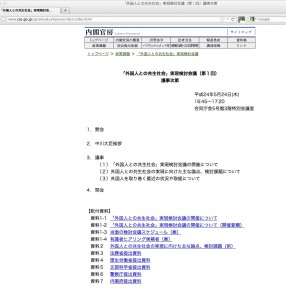
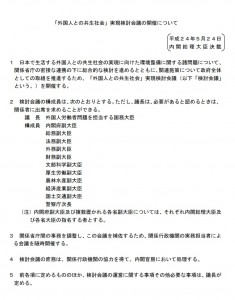
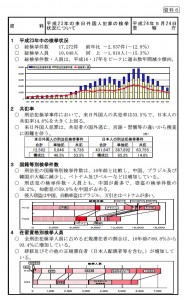
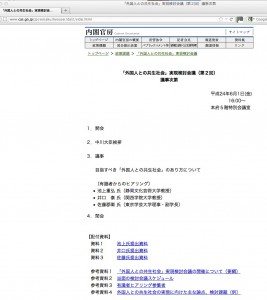
20 comments on “GOJ embryonic policymaking reboot for “co-existence with foreigners”: Some good stuff, but once again, policy about NJ without any input from them”
Great post and overview of the GOJ material. Thanks!
I dont need to read it all to think “how patronizing” and also, a pointless gesture. The foreigners are already here, “coexisting” or rather, doing the best they can.
This whole phrase though, sounds like 70s Soviet foreign policy of detente, “peaceful coexistence” or “putting up with foreigners as we cannot beat them, because it suits us.”
Glasnost it ain’t. Too little too late, in my opinion. We need a completely new mindset recognizing the status quo, not mere posturing of a government that thinks it somehow is the prime mover in the meaningful movement of peoples.
And the same old sh*t about how they want “Koudo Jinzai” when in fact most NJs settling here post 3/11 may not fit this definition, as Debito says above “even though most of the NJ these labor policies will attract are probably not White people — because they never have been). In sum, the MOJ offers nothing new except more policing.”
Alot of elite ethnic Chinese in the finance world who certainly are Koudo Jinzai are also not really bothering too much with Japan, they regard it as small potatoes, too slow and they feel the Japanese do not do their homework, “just wasting our time and the Japanese over protect themselves” though I cannot reveal my sources of this quote as it would get me fired.
There seems really nothing new that is likely to come from this.
As such, a question arises: why is this effort even in place?
NJ are unlikely to benefit; J are unlikely to care [so long as nothing arises from this].
The underlying issues of marginaliation and human rights are unlikely to arise.
@Debito
Very interesting.
After a quick look, I have to ask, what’s all this concern about ‘protecting our country’s reputation’? Who do they think is caring about Japan’s reputation? If they mean the outside world where the NJ all come from, then it shows that they just haven’t got a clue. Missing the hypocrisy completely.
It just sounds to me like this is more manipulation, done not so much for domestic consumption, but to make it look to outsiders like Japan would LIKE to open to the outside world. It may be that the Japanese government is uncomfortable with the number of residents they gave PR to, simply because they managed to be the low-hanging fruit that lasted 10 years, (i.e. willing to underbid any other NJ labor, not bringing any corporate, professional or scientific experience, etc.) They got any number of people who couldn’t succeed any place else, but Japan isn’t being able to squeeze them for any political benefit. So the bureaucracy says, “Back to the drawing board!” Nice taraimawashi.
They did this about some English-teaching exchange program with America (not JET). Either Noda or Kan lamented that they wished they had more native Japanese teachers who were fluent in English, and not have to “rely” on foreigners who aren’t fluent in Japanese. The solutions to their language problem were put to extremes, rather than recruit the number of able, bilingual native Japanese, and the number of talented English-speaking Westerners who aren’t fluent in Japanese, but aren’t necessarily “exchange program” focused young people.
Japan is great at convening study groups to kick problems down the road, to evade, to obfuscate, or stonewall. They don’t seem to be too good at coming up with workable solutions that make sense.
With respect;
Regarding the most inflammatory phrase in the above summary, I don’t think Material 2 actually states “being opened up as an international society will probably lead to our country’s reputation being downgraded”. The gist of the original Japanese is that if we do not resolve the existing problems facing the international community in Japan “Japan’s reputation as an open country” (i.e. attractiveness as a destination for prospective immigrants) risks being affected. The key phrase is “hirakareta kuni TOSHITE no hyouka” – i.e “reputation AS an open country”. Since Debito has kindly summarized a mountain of information extremely quickly, it is perhaps unkind to nitpick over this, but if “being opened up as an international society will probably lead to our country’s reputation being downgraded”were true, the original Japanese would have to be along the lines of “hirakareta kuni ni nareba, kuni toshite no hyouka ga teika suru”, which is not quite the same thing.
Anyway, I am also cautiously optimistic over this meeting (except for, as Debito mentions, the unnecessary involvement of the plod).
— Thanks. As I said, corrections appreciated. So the assumption is that Japan is an open country? Boggles.
FYI, and off topic…
I heard that CNN ran a segment Sunday night on immigration, with a segment of that about Japan and the debacle with the NJ nurse exams.
A quick google search turns up this: http://globalpublicsquare.blogs.cnn.com/2012/06/10/immigration-lessons-for-the-u-s-from-around-the-world/?hpt=hp_c2
CNN World June 10, 2012 10:41 AM ET
Immigration lessons for the U.S. from around the world
By Fareed Zakaria
Fareed Zakaria looks at how the immigration systems work – and don’t work – in Japan, Europe, Canada and the U.S. in the TV special: “Global Lessons: The GPS Roadmap for Making Immigration Work” which aired on CNN on Sunday, June 10. Watch on CNN International on Saturday, June 16, at 4 a.m. and 9 p.m. ET
Immigrants founded America hundreds of years ago, coming to the promised land in search of freedom and opportunity, in pursuit of the American dream.
Today, many Americans see immigrants as a danger to that dream.
They worry that immigrants are taking their jobs, using government services and changing the country’s national identity. The average American believes that 39% of the U.S. population was born abroad. The real figure is 13%, still the highest level since 1920.
Immigration is divisive, a wedge issue in this election year. But most Americans (73%) agree that the government is doing a poor job of managing it.
So, how should the U.S. handle immigration? Does anyone else do it better? What can the U.S. learn from successes – and possible mistakes – from other countries?
Let’s look at three examples: Japan, Europe and Canada.
JAPAN: A CAUTIONARY TALE
Japan has one of the strictest immigration policies in the world and has historically been closed off to outsiders. It has a foreign population of less than 2% – six times smaller than the percentage of the U.S.
But what are the effects of keeping foreigners out?
Japan is facing an alarming labor shortage, says Robert Guest, the business editor of The Economist and author of “Borderless Economics.”
Japan’s current population is around a 127 million. It’s on pace to be just 90 million by 2050, a drop-off of almost one-third. The nation is also aging. Almost one in four people are 65 or older – making Japan the oldest country on earth.
Guest says there’s a solution to the labor shortage: open the borders and invite more immigrants.
But that idea has hurdles.
“They don’t have the idea that you can become Japanese,” says Guest. “And they don’t have the idea that you can solve some of the country’s chronic labor problems by importing foreign hands.”
In its health care sector, for example, Japan is estimated to be short almost 900,000 workers 2025. It started to invite foreign nurses, and since 2008 almost 600 have come to Japan.
But only 66 have passed Japan’s notoriously difficult nursing proficiency exam, which requires an expertise in written Japanese.
Japan’s health ministry has made the test easier, adding some English translations, but critics say it’s still unreasonable.
“It should be good enough that they are able to communicate verbally with people and that they are able to read the words they need to know for the tools of their trade,” says Guest. “It worked perfectly well in other countries.”
And it’s not just foreign workers who might run into obstacles. In some cases, it’s immigrants who have been living in Japan for decades.
In 1990, facing a labor shortage, Japan gave ethnic Japanese from South America long-term residence status, filling gaps in its workforce.
Japanese-Brazilians filled manufacturing jobs and became the third largest minority in Japan.
But in 2009, with unemployment running high, Japan actually offered money to them to leave the country – $3,000 for each worker to cover travel expenses.
And the flight was essentially a one-way ticket – anyone who took the offer couldn’t come back to Japan with the residence status they once had.
The government says it was only trying to help unemployed Japanese-Brazilians. They’ve stopped offering the deal and are reconsidering the residence status of those who took the money.
So if Japan won’t let in immigrants, what is it doing about its labor shortage?
It’s encouraging families to have more children, giving them $165 a month for each child. But that hasn’t been enough to inspire a growth spurt.
Rest at http://globalpublicsquare.blogs.cnn.com/2012/06/10/immigration-lessons-for-the-u-s-from-around-the-world/?hpt=hp_c2
ENDS
@ jim above. Investors care (the J Govt think) about whether or not it is worth investing in Japan. But like was said elsewhere, various monied Chinese are not too interested in dealing with Japan due to the effort it takes compared to the return it yields (other than land purchases)/more attractive markets elsewhere/a spreading reputation for racism/a reputation for being “difficult”.
It does not even matter if all the apologist were right and it was not racism, it was just “japan’s unique culture”- it still means Japan is not foreigner friendly and too much of a nuisance to bother with in serious business. Even if this is NOT true, it is what NJ investors are coming to believe. If China and Japan are equally difficult, or equally (un)trustworthy, many will go for the larger market.
I cannot reveal my source except to say he is a millionaire and although he sometimes comes to Japan on business, but Japan is a tiny, tiny part of what he does now.
A correction:
“2.There have been “social costs” (shakaiteki kosuto) to bringing foreigners into our country before, particularly in regards to lifestyles, education, and labor, so this should not be broadened due to [and I’m seriously translating this bit:] “being opened up as an international society will probably lead to our country’s reputation being downgraded” (kokusai shakai ni okeru hirakareta kuni to shite no hyouka o teika saseru koto ni mo tsunagaru). [Moodys, are you listening?]”
The original text here reads:
“一方、我が国で生活している外国人については依然として生活・教育・就労面等での問題が存在し、このような状況が拡大することは、社会的コストの増大や、国際社会における開かれた国としての評価を低下させることにもつながるのではないか。”
I would translate/interpret this as follows:
“On the other hand, as regards foreigners living in this country, there continue to exist problems relating to living, education, labor and the like. Would an expansion of this situation [i.e. ‘would the worsening of these problems’] not lead to an increase in social costs, as well as the decline of [Japan’s] reputation in the international community as an ‘open country’?”
— Yes, quite. Again, thanks you two. I am not free from the scrutiny I’m doling out to the GOJ myself.
Again, do Japan’s bureaucrats really consider Japan an “open country”? Compared to pre-Meiji, sure. But I have the feeling that many NJ members of the labor market (which is precisely what this interministerial discussion is apparently trying to address) and the NJ business community might disagree.
Wow! Who are they kidding?! The foreign population of Japan fell by 56,000 last year, the third consecutive annual drop. What’s all this talk of “koudo jinzai”? The way Japan is going, they’ll be lucky to get halfwitted banana salesmen from Jakarta bus stations (the fully witted ones opting for Shanghai, of course). Why would anyone, “koudo” or otherwise, want to go to a country that treats them like second class citizens? A country with an arbitrary and opaque immigration system? A country that is in the midst of an economic tailspin? Don’t these geezers realize that they missed their chance? Sure, in the last 80s, real high-level talent actually wanted to come to Japan. It was thought that if you could speak Japanese, that was all you’d need in life to succeed. All the smart guys wanted to come to Tokyo. Now, it’s like, “Japan? Really? I don’t want to eat radioactive food! I don’t want to be an English teacher!” It’s a quaint backwater, at best.
And yes, one cannot fail but notice, as Debito points out, the complete lack of foreign input. As usual, the Japanese government operates as a kind of echo chamber: the same old geezers bouncing the same tired ideas off each other. Make absolutely no mistake: this modus operandi is exactly why Japan is the stagnant and backwards place it is today.
They’ll still be convening their idiotic meetings and publishing their ridiculous conclusions in 25 years, and the only thing that will have changed is that Japan will be poorer, older and more stagnant. It will still be mono-ethnic, mono-lingual place run by a bunch of regressive old men.
Why bother? Why fight it? Laugh at it! The geezers in charge are obviously a very slow, very black form of comedy.
@ Debito re: “So the assumption is that Japan is an open country? Boggles.”
Yes, Japan clearly needs to focus on how to attract and retain kodou jinzai, from the perspective of realising that it is currently not competitive in this regard with the likes of Canada, Australia, New Zealand, the UK, etc… It is widely known that Japan has procrastinated for too long about whether they can deem to accept such talent, while other countries have been proactively benefitting from them by offering equitable and attractive opportunities for them to come, prosper, settle, and stay. And they need more like 200,000 a year, than 2,000. As usual, lots of hand-wringing, but too little, too late.
I think it’s not that the assumption is that Japan is an open country. Rather, it’s that Japan’s _reputation_ as an open country would suffer (without commenting on how _much_ of a reputation it has as an open country to begin with). I think it’s used in the following sense, which may be more easy to process in your context and worldview (not seeing Japan as a terribly open country):
If I were a naturalized ethnically African Japanese citizen having lunch with Blinky the Tochiji, and I demonstrated an astonishing inability to use chopsticks, my hyoka as a Nihonjin in the eyes of Blinky would suffer.
(Side note / minute distinction not worth mentioning: I don’t see Japan as that closed of a country, but rather that it is a generally open country with a bit of a blind spot for issues of diversity and discrimination in general.)
AJ#6
I am interested in your statement:
“I am also cautiously optimistic over this meeting”
What are your grounds for optimism?
Do you sense a new political will in government or amongst J regarding a strong desire “for realizing a society where we can coexist with foreigners who have livelihoods in Japan”?
Same as the posters above, I don’t see anything new about GOJ’s political window dressing. Their awkward, archaic use of language in the official documents shows that their attitude will remain the same as usual—indefinitely, maybe. It’s their distinctive way to put on the AIR—Ambiguous, Indifferent, Reluctant. Somebody’s got to tell them the very basic thing about multi-cultural politics: it doesn’t make sense to hold a “cultural diversity committee” without having NJ or Japanese of international as its member.
About the “Air” above- excellent word. It also dovetails with what sociologists identifed in the 60s as an old Japanese “battle tactic” which is to first ignore the enemy/vendor or appear disinterested until you can assess their strength. A kind of Japanese version of “keep em mean to keep em keen”. Or playing cards close to one’s chest, but more aloof.
Am I alone in thinking I was chasing after Japanese companies (which in fact needed what I had to offer, but never admitted it) in the 80s? They want to be chased, courted, flattered. They rarely do the chasing.
I think nowadays though this hurts Japan’s investment chances, especially with seemingly keener, more enthusiastic, more “open” business opportunities elsewhere in east Asia.
I’m surprised that no one has pointed out how this report reflects the deeply held attitudes that Japanese have to foreigners and immigration. In order to understand just how insular and xenophobic their thinking is, it’s necessary to look at the immigration policies of a truly immigrant-friendly and multicultural society like Canada or Australia. If you look at their immigration websites or immigration policies, you’ll see no talk of having to “co-exist” with foreigners (the way one might learn to live with chronic pain or unpleasant neighbors). The whole language of “us versus them” does not come into it. In truly multicultural countries, the understanding is FIRST that we are all people and SECOND that all people can potentially become full members of the society which admits them. How far Japan is from this idea! The whole report above is like a screaming admission of how far Japan is from becoming a true multicultural society.
The report is a clear statement of the most deeply held Japanese belief: that Japanese are Japanese and foreigners are foreigners. Sure, Japan might have to learn to accept a few foreigners in their midst due to labor shortages, but NEVER will they accept the idea of foreigners becoming full members of their society.
I mean, just look at the Zainichi – they’ve been in Japan several generations and they’re not accepted. Look at the descendants of American whalers on Chichi-jima – they’ve been in Japan six or eight generations and they’re not accepted.
Here’s the sad truth: Japan is not capable of becoming a multicultural society. At least, not in the next several decades and probably never – not as long as Japan is recognizable as the country it is today. Their cultural prejudices and worldview make it an impossibility. To understand just how far Japan is from becoming a multicultural country, just try the following thought exercise: Try to imagine the Japanese government publishing a paper that didn’t refer to “gaikokujin” and “Nihonjin” or “Nihon no kokumin”. Try to imagine a Japanese government report on immigration talking about “ningen” instead. And try to imagine in talking about these “ningen” becoming full members of society. Totally unimaginable, no?
As it is, the government comes out with a paper that talks about having to create a society (meaning, Japanese people) that can coexist with foreign people, as if it were some unendurable thing that must be endured.
My advice to all foreigners living in Japan or thinking of doing so is this: Think carefully about trying to join a society that actively tries to keep you out (or, that will never consider you a real member).
Eric
I am slightly more optomistic than you, I think it is mainly just the J govt (and the old fogies who believe them)that is out of touch and using the “old map” of signs and symbols that describe the real world.
There are in fact plenty of mixed race people doing well as Japanese, (although why they have to “pass” as a “real” Japanese is objectionable)- Crystal the newsreader being one example- I mean she reads the news fer chrissakes! Only a reactionary a-hole would call her a gaijin, and he got loudly berated as a result fo being rude and ignorant to do so.
The problem is there are quite a few of these reactionary aholes in power, but at the grassroots level there is quite a lot of mixing going on and there is not much they can do to stop it. Sure, they and certain media may try to discourage J women for marrying foreigners etc, but 1. they are preaching to the converted 2. it has not stopped J men marrying non Japanese (the largest group of international marriages) and producing kids from a more diverse background yet fluent in Japanese.
It is like a fait accompli to an annoying or ineffective government.Or as an earthy senior manager of Nissho Iwai once said to me “people are going to f##k whoever the want anyway!”
On the plus side, a large aging population means a more rapid wholesale shift of values when they have all died off and half kids like my own come of voting age.
With regards to Eric’s comments, I’d be surprised to hear Americans talk about “humans” (ningen) in all of our foreign policy rather than all the things that Americans supposedly want. If I have to hear one more news blurb about American’s being protected by law X but that won’t apply to, say, a Pakistani or Afghani, I’m going to scream. We need to all push for governments that start talking about policies good for all global citizens, not just their geographical constituents.
UPDATE JUNE 27, 2012: MEETING THREE OF JUNE 15, 2012 CRITIQUED HERE:
GOJ Cabinet “Coexistence with NJ” Pt. 2: Critique of June 15, 2012 meeting — a very positive Third Act to this Political Theatre
http://www.debito.org/?p=10359
you claim that there were no foreigners at this meeting but surely Bill Murray must have been there?
this sounds like a scene out of the movie Groundhog Day.
ive been reading reports of these meetings for the last 15yrs
and they are always the same and nothing ever changes..